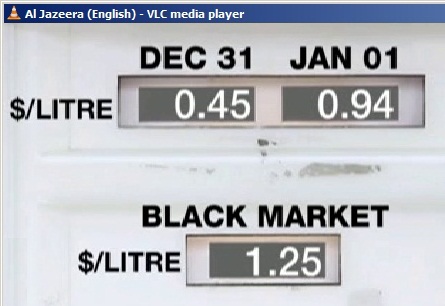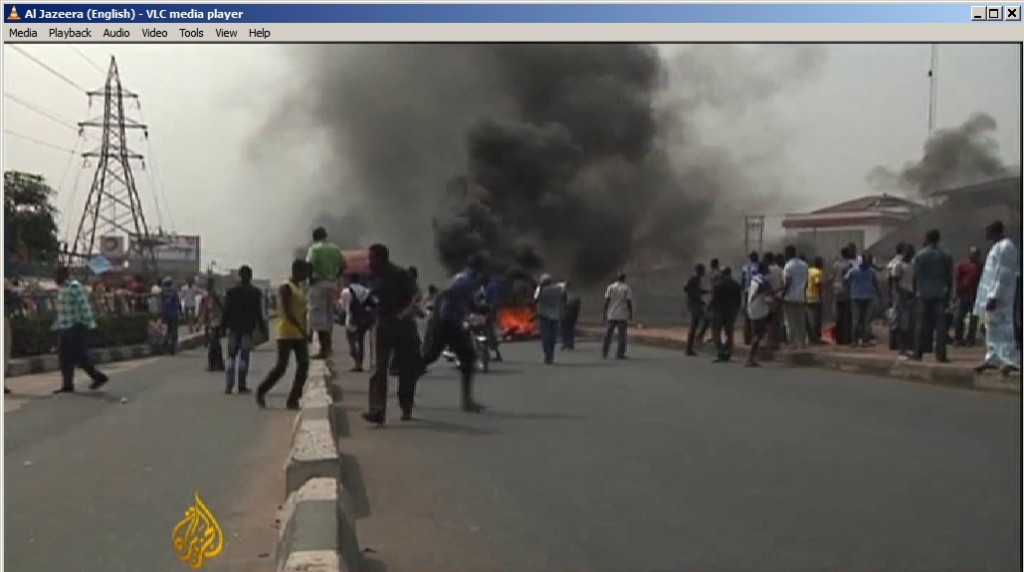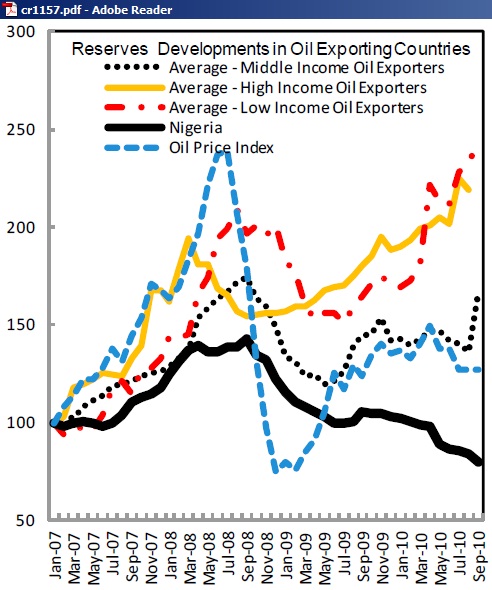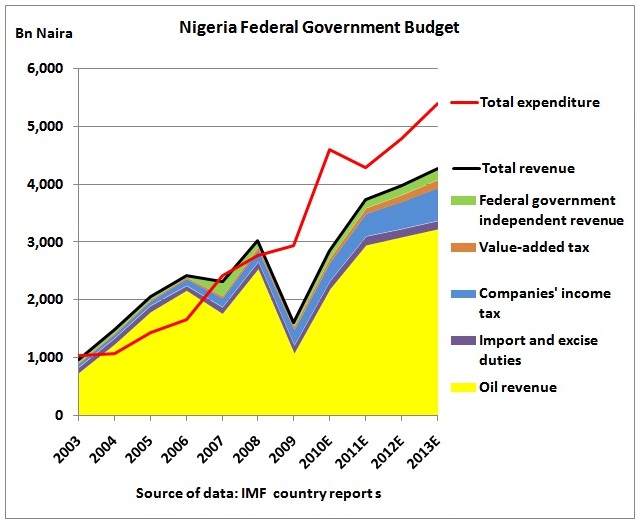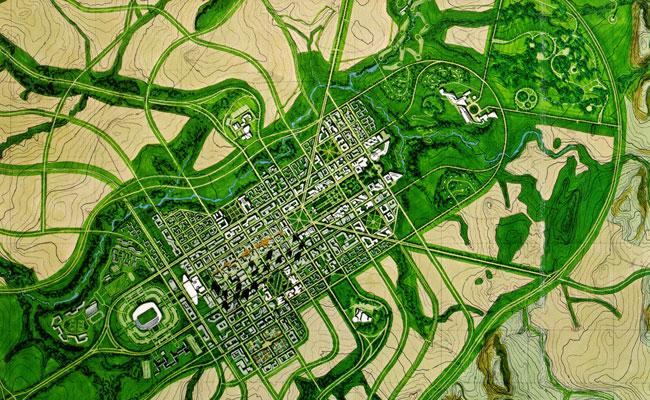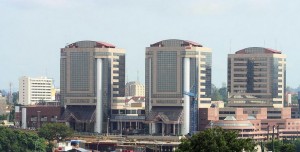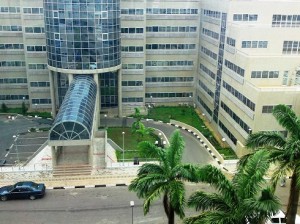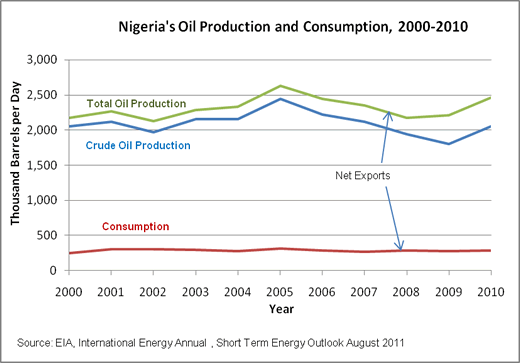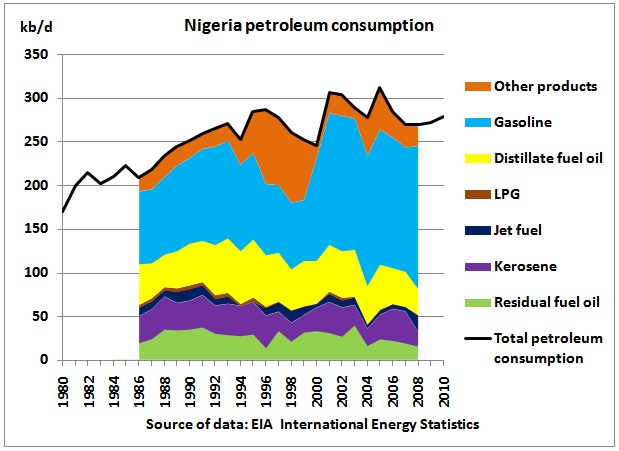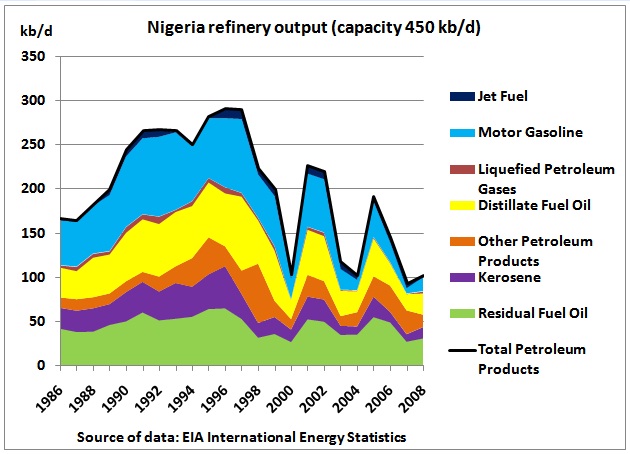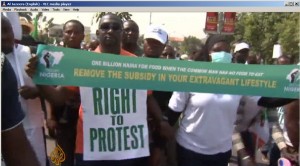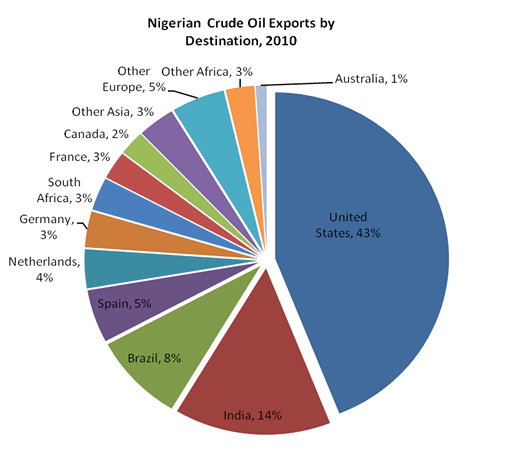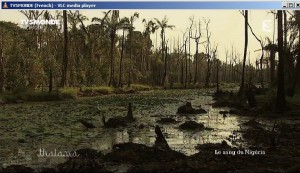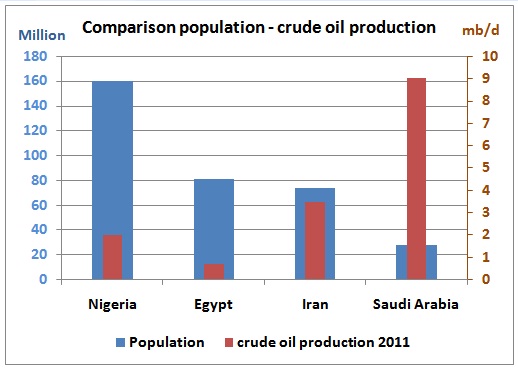Fuel subsidies in oil producing countries are a big problem not only because they are a burden for budgets but also because they result in an inefficient oil supply environment.
This problem is first surfacing in oil producing countries which have to import fuels or crude oil (at world market prices) because either their refining capacity has not been increased along with rising local demand (Iran) or because they have become a net oil importer (Egypt) after their oil production peaked. And that happens as the population in these countries expects low fuel prices not least because they are continuously being told their countries are awash in oil, with growing oil reserves.
Now it’s Nigeria where fuel prices at the pump were increased over night:
The protests were prompt:
http://www.aljazeera.com/news/africa/2012/01/2012110174740181593.html
The IMF’s last assessment is from February 2011 (as Nigeria is on a 12 month Article IV consultation cycle, the next report will be due soon). Here are some extracted highlights in relation to oil:
3. The pro-cyclical fiscal stance reflects the lack of adherence to the oil revenue rule.
The current rule and the associated Excess Crude Account (ECA) were established in 2004 to manage revenue volatility and improve the conduct of fiscal policy across all levels of government. It had been effective until recently, with the pro-cyclicality of public spending declining substantially during 2005-8 as surplus oil revenues were sterilized in the ECA. However, in the absence of a sound legal foundation, the implementation of the oil rule and savings in the ECA depended on the informal agreement among various tiers of government, leading to ad hoc disbursements from the account. Thus, despite world oil prices and domestic oil production well in excess of the budget benchmarks in 2010 [$ 60 a barrel], the government spent all current oil revenues and drew on savings in the ECA at a time when stabilization called for a rebuilding of ECA balances.
5. Nigeria’s external balance deteriorated in 2010 despite a favorable external environment.
The terms of trade improved by 13 percent, following a drop of some 22 percent the previous year. With oil production and oil prices up sharply, oil export values jumped 25 percent. However, the current account surplus declined from 13 percent of GDP to 6.6 percent as imports of (nonoil) goods and services surged by some 33 percent. The capital and financial account—particularly foreign direct investment—also deteriorated as investors wait on the outcome of the Petroleum Industry Bill, which remains under consideration with the National Assembly. International reserves fell to about 6.6 months of (next year) import cover by the end of the year. These developments are in sharp contrast to the experience of other oil exporting countries, where current account positions improved on average by 3 percentage points and international reserves are generally rising. Nigeria’s external debt remains low, at about 2.2 percent of GDP, and the joint Bank-Fund debt sustainability analysis indicates that the risk of external debt stress is low.
http://www.imf.org/external/pubs/ft/scr/2011/cr1157.pdf
From Fig 4 of IMF report 11/57. Nigerian foreign exchange reserves are declining. That explains the drastic measures now taken.
Details of the Federal Government’s budget position are in table 3a on page 22, put in a graph:
Using data from previous years 2003-2006 from this web site
http://www.imf.org/external/country/nga/index.htm?type=9998#56
we can see that in 2009 expenditure started to exceed total revenues and that this trend will continue under IMF assumptions.
The explicit fuel subsidy is tiny in this graph. Regardless where the “implicit” fuel subsidy is hidden, growing personnel and overhead expenditure of the Federal government suggests the problem of growing expenditure goes deeper than the issue of fuel subsidies.
Could it be that a growing bureaucracy in the Capital Abuja consumes more than their fair share? Let’s have a look:
Masterplan of Abuja. Nigeria joined Tanzania http://crudeoilpeak.info/sustainable-cities-master-plan and Malawi http://zambia.maruien.com/malawi/lilongwe_map01.gif in transferring their capitals in a move to get away from colonial settlement structures. But for Nigeria the oil revenue is tempting to outbid her African brothers on the other side of the continent.
Watch this 10 min video about Abuja http://www.youtube.com/watch?v=eqLtVmnsfmc
A year after the IMF report, a good description of the current situation can be found in this article:
Nigeria’s Chance for Reform
13/1/2011
The gasoline subsidy embodied the worst characteristics of the country’s economic governance. In 2011, the subsidy on gasoline cost the government over $9 billion, more than the entire federal government capital budget and about double the subsidy’s cost in 2010. Global fuel prices did not, of course, double during this time period. Nigeria’s tab skyrocketed thanks to the costly, corrupt system by which the country produces and imports gasoline, as well as rising interest charges and insurance premiums as government failed to pay fuel importers on time.
NNPC Head quarters in Abuja
By the end of 2011, Nigeria owed importers over $4 billion. Relying on the Nigerian National Petroleum Corporation (NNPC), the national oil company, the government devised complex, opaque methods for covering import costs, including swap deals where crude oil was awarded to commodity traders in exchange for gasoline and other refined products.
Officials allowed the subsidy to rise because it included lucrative opportunities for corruption. In 2009, then President Umaru Yar’Adua called the manipulation of prices and supplies “the greatest institutional corruption in the history of the nation.” Only when NNPC faced bankruptcy — owing billions of dollars to importers as well as to the treasury — did the government decide to end the subsidy
http://www.huffingtonpost.com/alexandra-gillies/nigerias-chance-for-refor_b_1204853.html
Details of the new policies of the Nigerian government to address this situation can be read on the website of the Ministry of Finance.
FAQ on Deregulation of the Downstream Petroleum Sector and Removal of Fuel Subsidy
2. What is the rationale behind the government’s plan to deregulate the downstream petroleum sector?
Deregulation of the downstream oil sector will improve the efficient use of scarce economic resources by subjecting decisions in the sector to the operations of the forces of demand and supply. This will attract new sellers, buyers and investors into the market, thereby increasing competition, promoting overall higher productivity and, consequently, lowering prices over time.
…..the price of petrol is currently pegged at N65 per litre but the actual cost of supply is about N138 per litre at crude oil price of $110 per barrel. Therefore, the subsidy element is about N73 per litre.
11. How much does the government spend on subsidy?
Between 2006 and August 2011, total government expenditure on petroleum subsidy amounted to N3.7 trillion. Expenditure on subsidies increased from N261 billion in 2006 to N673 billion in 2010, which represents an increase of about 160%. Additionally, there have been unprecedented payments in 2011 that so far amounted to N1.4 trillion due, in part, to two key factors: increase in subsidy per litre as a result of rising global oil price, and large arrears due NNPC for household kerosene imports.
http://www.fmf.gov.ng/component/content/article/3-trendingnews/63-faqfuelsubsidy.html
Now let’s finally turn to oil statistics, first from the BP Statistical Review, to give us a long term view since 1965:
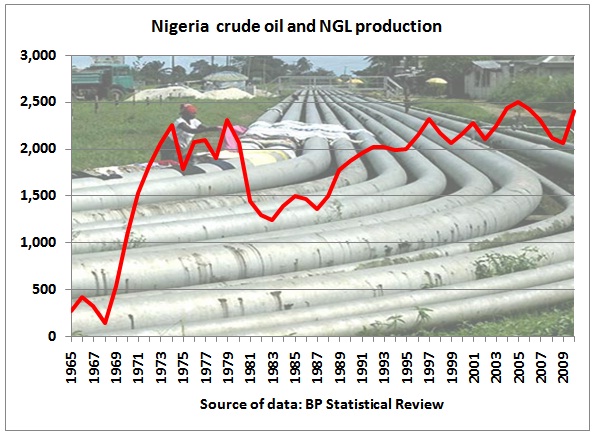 The underlying image shows how Nigeria’s oil wealth bypasses the general population where oil pipes are just good for drying clothes. This disconnect is reflected in local consumption being practically flat, as shown in this graph from the EIA, US Department of Energy:
The underlying image shows how Nigeria’s oil wealth bypasses the general population where oil pipes are just good for drying clothes. This disconnect is reflected in local consumption being practically flat, as shown in this graph from the EIA, US Department of Energy:
http://www.eia.gov/countries/cab.cfm?fips=NI
A bumpy crude production plateau is topped up by growing natural gas liquids (Note that in the EIA International Energy Statistics “crude oil” is 400 kb/d higher and includes NGLs). Whatever the definitions of crude oil are, the EIA graph does not look like the typical Export Land Model where growing consumption approaches declining production, leading to export extinction. Let’s have a closer look at the consumption, using data from the same EIA:
We see a very modest increase of less than 100 kb/d over a long period of 20 years, despite a doubling of population since 1975, a trend which is likely to continue:
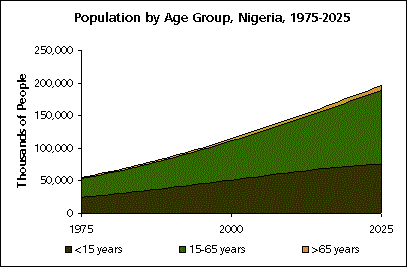 http://earthtrends.wri.org/text/population-health/country-profile-137.html
http://earthtrends.wri.org/text/population-health/country-profile-137.html
We see a declining refinery utilisation with major disruptions. A good description of the situation comes from Nigeria’s Oil and Gas Publication Ltd:
Nigeria, which is Africa’s largest crude oil exporter and also the 6th largest in the world, spent about N1.15 trillion to import an estimated 8.1 million metric tons (MT) of petroleum products in 2010 alone and will spend about N388.11bn to import petrol, in the first quarter of this year.
Ageing refining plants, dilapidated infrastructure, such as pipelines linking the plants and a lack of investment have held back the country’s refining industry for years, while militant attacks have worsened the situation.
http://www.nigerianoilgas.com/?p=518
A lot of syphoning of crude from pipelines for bush refineries:
Depuis cinquante ans, le Nigeria est un Eldorado pour les compagnies pétrolières du monde entier. Un Eldorado et un enfer. Dans le quatrième pays producteur de l’Opep, les profits sont colossaux, mais dans des conditions extrêmes de violence et d’injustice. Prises d’otages, corruption, attaques, pollution massive et destruction de l’environnement sont l’envers de cette industrie. Le delta du Niger est aujourd’hui une des régions les plus dangereuses du monde. Pays le plus peuplé d’Afrique, le géant est très malade.
http://www.thalassa.france3.fr/?page=prochainement&rep=2635
The above description explains the deep-rooted discontent which now boiled over:
Oil production outlook
We take Richard Miller’s projection presented at the Energy Institute in November 2010:
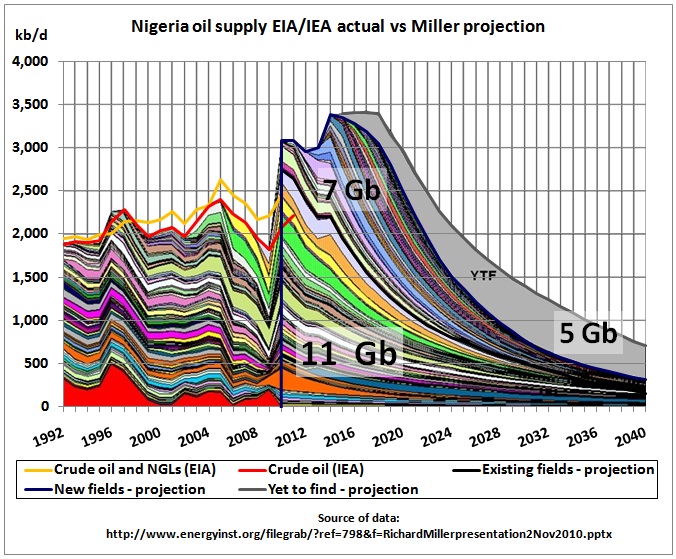 and draw actual production curves for crude oil (IEA, red) and crude oil plus NGLs (EIA, orange). We see the decline in the existing fields and the need to replace them with new fields, mainly from deep water. The trend in the last 10 years does not suggest that production will reach the projected 3 mb/d any time soon, not to mention a peak near 3.5 mb/d.
and draw actual production curves for crude oil (IEA, red) and crude oil plus NGLs (EIA, orange). We see the decline in the existing fields and the need to replace them with new fields, mainly from deep water. The trend in the last 10 years does not suggest that production will reach the projected 3 mb/d any time soon, not to mention a peak near 3.5 mb/d.
Note that oil produced until 2040 is in the order of 23 Gb while remaining reserves as published in the BP statistical review are claimed to be much higher, 37 Gb.
The above profile is quite similar to what Colin Campbell from ASPO published in his book “An Atlas of oil and gas depletion”. Oil produced up to 2030 is depleted by 60% as of 2010.
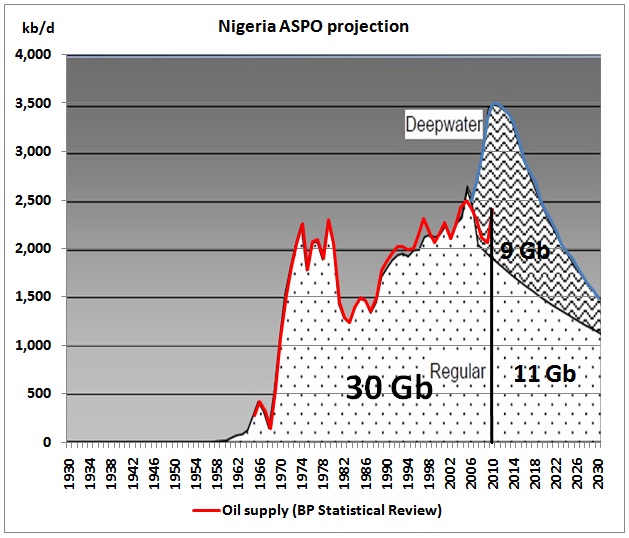 http://www.energiekrise.de/e/aspo_news/aspo/Newsletter092.pdf
http://www.energiekrise.de/e/aspo_news/aspo/Newsletter092.pdf
Colin sums up: “Nigeria will continue to be an important source of world oil for the next two decades, especially as its deepwater production comes in. It will also earn high revenues as oil prices rise higher. Further strife and violence will likely erupt when it is found that falling oil revenue can no longer support the large population. The country is already a substantial net food importer. In fifty years or so, the daily life for the survivors may be little different from the sustainable patterns the country knew in the 19th Century.”
Medium Term Outlook
The monthly oil market report of the IEA (Dec 2011) contains a medium term update of OPEC crude production capacities (not production) on page 22 and for Nigeria this looks like this:
 Source of data: http://omrpublic.iea.org/
Source of data: http://omrpublic.iea.org/
We see that production is substantially lower than capacity. Even the capacity is nowhere near the sharp increase to 3.5 mb/d shown on the above graphs.
Oil dependency on Nigerian oil exports
Light sweet crude oil export destinations from: http://www.eia.gov/countries/cab.cfm?fips=NI
Australian crude oil imports from Nigeria
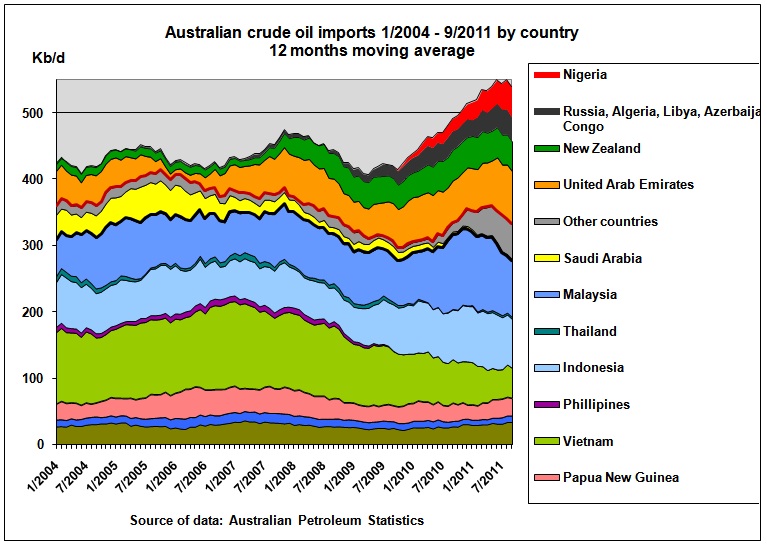 Crude oil imports from Asian suppliers have already peaked in 2007 due to peaking oil production in these countries. Since then Australia has diversified its crude oil sources, and we see that a substantial part of the growth in imports comes from Nigeria. Well done, Australia! Few Australian motorists would know that around 10% of petroleum products from Australian refineries rely on Nigerian crude. Even fewer would know that the Energy White Paper (EWP), released in November 2011, specifically mentions diversification as something which allegedly increases our energy security:
Crude oil imports from Asian suppliers have already peaked in 2007 due to peaking oil production in these countries. Since then Australia has diversified its crude oil sources, and we see that a substantial part of the growth in imports comes from Nigeria. Well done, Australia! Few Australian motorists would know that around 10% of petroleum products from Australian refineries rely on Nigerian crude. Even fewer would know that the Energy White Paper (EWP), released in November 2011, specifically mentions diversification as something which allegedly increases our energy security:
On page 58
- Unexpected events – market or geopolitical – will almost certainly happen, possibly more frequently than in the past.
- Australia’s access to well‐established and diverse international supply chains suggests that such risks or outcomes are more likely to affect energy prices rather than compromise in a sustained way Australia’s physical energy supply.
and on page 73:
“Liquid fuels energy security is assessed as high, trending to moderate in the long term, as Australia has continued access to highly adequate and reliable supplies of liquid fuels at prices that are manageable within the broader economy.”
http://www.ret.gov.au/energy/Documents/ewp/draft-ewp-2011/Draft-EWP.pdf
This is how the EWP uses “clever” semantics to argue away any problems like the ones we see in Nigeria. Many hard lessons will have to be learnt.
But then again, the Clyde refinery in Sydney will be closing by 2013, so less crude imports will be needed, to be replaced by fuel imports from Asian refineries where there is heavy competition. That won’t come cheap.
We may also note that embellished environmental impact studies for new toll-ways in Sydney, like the M2, have no problems with writing this: “The management of waste is not considered a key issue given that standard measures are available to address waste generation, disposal and reuse in order to minimise potential impacts” (EIS M2 widening, p 401). But look at this:
Up: Oil waste land from leaking and sabotaged oil pipelines. According to the IEA OMR report Dec 2011 repair bills for 2011 alone were $2 bn.
Well, that is the environmental cost left behind in Nigeria of around 5% of all fuel use on any tollway in Australia.
Conclusion:
The need for the reduction of fuel subsidies in oil producing countries is one side-effect of peak oil. Higher oil prices impact on different countries in different ways, triggering social unrest, depending on the pre-condition of the economy. The ratio oil production to population is an important metric in the long term. In this respect, Nigeria is a bit better off (12.5 kb/d per million population) than Egypt (9 kb/d). Iran has 47 kb/d per million population and Saudi Arabia 321 kb/d. But as we can see the internal workings of these countries are quite different.
When oil importing countries assess their oil vulnerability they must not only look at past oil statistics, remaining reserves and realistic production projections of their suppliers but also need to analyse in detail the economic and financial performance of the countries where these supplies come from and which impact that has not only on the oil & gas industry but also on the socio-economic environment. In the recently published liquid fuels vulnerability assessment of the Australian government such analysis – country by country – was not done. That is why we are going to have some surprises.
Update 17/1/2012
Nigerian Unions call off national strike
Union leaders in Nigeria have called off a week-long nationwide strike that has been paralysing the country’s economy, following a decision by President Goodluck Jonathan to roll back fuel-price increases.
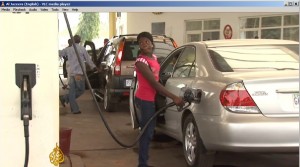 Worried looks: petrol is still 50% more expensive than last year
Worried looks: petrol is still 50% more expensive than last year
http://www.aljazeera.com/news/africa/2012/01/201211664250732714.html
Nigeria’s fuel prices
16/1/2012
- Previous price in petrol stations: $0.40/ litre
- Price in petrol stations after subsidy removed: $0.86
- Latest price: $0.60
- Previous black market price: $0.62
- Black market price after subsidy removed: $1.23
- Annual cost to government of subsidy: $8bn
“However,” he [President Jonathan] added, “given the hardships being suffered by Nigerians, and after due consideration and consultations with state governors and the leadership of the National Assembly, government has approved the reduction of the pump price of petrol to 97 naira (about $0.60) per litre.”
The price of petrol had risen from 65 naira ($0.40; £0.26) to 140 naira per litre when the subsidy was removed on 1 January.
http://www.bbc.co.uk/news/world-africa-16571637
Why the problem is not solved:
The Ministry of Finance writes in the above mentioned FAQ web site:
6. Why not a staggered, phased removal of fuel subsidy, if at all?
The removal of subsidies in phases has never worked in any country and there is a strong likelihood that it will not work in Nigeria. A partial removal will lead to partial results because investors will continue to be discouraged and the distortions and inefficiencies existing in the sector, such as smuggling and rent-seeking behavior, will continue. A gradual deregulation will imply that substantial amounts of money will continue to be spent on fuel subsidy through continued borrowing. This will imply that future generations of Nigeria would have to repay part of the debt being contracted. The optimal policy response, therefore, is to remove it once-and-for-all.
http://www.fmf.gov.ng/component/content/article/3-trendingnews/63-faqfuelsubsidy.html
Source of pictures:
NNPC towers
http://sweetcrudereports.com/wp-content/uploads/2011/09/NNPC-Towers.jpg
Ministry of Finance:
http://www.nairaland.com/nigeria/topic-118277.1056.html
Masterplan of Abuja
http://www.wrtdesign.com/images/projects/detail/13/1.jpg
Chapter 10.8 Waste Minimisation for Sydney’s M2 widening
